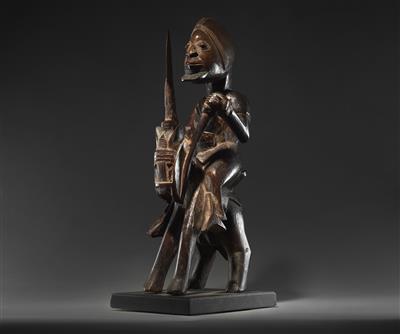A magnificent Yoruba equestrian figure, Nigeria. 19th century.

Wood, 77 cm.
This important sculpture depicts the king as a mounted warrior carrying a spear. The warrior's head is emphasized with prominent long bound hair. The Yoruba trace their cultural heritage to the founding city of Ile-Ife, one of the world capitals in the eleventh century. Many African city states were formed from here, each with their own king whose power was balanced by a council of elders. For over one millennium, the royal academies created a wide range of art forms designed to enhance the status of the king as well as other magical forces that bound him to his obligation as a ruler. The equestrian is a symbol of power, and is used to counterbalance the other classic sculpture in Yoruba art, the woman and child. The women are said to control magic and with that creation and destruction, the men are the protectors of the realm. A C14 test is available (CIRAM, ref. 0609-OA-130R).
Provenance
Important Belgian private collection. Merton Simpson, New York, years '70s. Cfr. Drewal & Pemberton, 'Yoruba African Art and Thought', New York 1989.
Expert: Joris Visser
 Joris Visser
Joris Visser
+32-2-514 00 34
Joris.Visser@dorotheum.com
21.06.2018 - 17:00
- Odhadní cena:
-
EUR 90.000,- do EUR 100.000,-
A magnificent Yoruba equestrian figure, Nigeria. 19th century.
Wood, 77 cm.
This important sculpture depicts the king as a mounted warrior carrying a spear. The warrior's head is emphasized with prominent long bound hair. The Yoruba trace their cultural heritage to the founding city of Ile-Ife, one of the world capitals in the eleventh century. Many African city states were formed from here, each with their own king whose power was balanced by a council of elders. For over one millennium, the royal academies created a wide range of art forms designed to enhance the status of the king as well as other magical forces that bound him to his obligation as a ruler. The equestrian is a symbol of power, and is used to counterbalance the other classic sculpture in Yoruba art, the woman and child. The women are said to control magic and with that creation and destruction, the men are the protectors of the realm. A C14 test is available (CIRAM, ref. 0609-OA-130R).
Provenance
Important Belgian private collection. Merton Simpson, New York, years '70s. Cfr. Drewal & Pemberton, 'Yoruba African Art and Thought', New York 1989.
Expert: Joris Visser
 Joris Visser
Joris Visser
+32-2-514 00 34
Joris.Visser@dorotheum.com
|
Horká linka kupujících
Po-Pá: 10.00 - 17.00
kundendienst@dorotheum.at +43 1 515 60 200 |
| Aukce: | Tribal Art |
| Typ aukce: | Salónní aukce |
| Datum: | 21.06.2018 - 17:00 |
| Místo konání aukce: | Wien | Palais Dorotheum |
| Prohlídka: | 16.06. - 21.06.2018 |
